When a revolution starts, it is expected to pave way for a future filled with freedom and political upheaval, but seldom do people realise that a revolution also leads to major bloodshed. This is the premise of Marat/Sade, a gloomy tale about the French Revolution and its aftermath, which was re-enacted last week at the National Academy of Performing Arts (Napa) festival.
Napa’s Dheeraj Laal Chaneeliya and Kashif Hussain translated the two-act play Marat/Sade in Urdu, which was originally written by Peter Weiss in German. The act was directed by Sunil Shankar. The play bore interesting insights into the conflict-stricken lifestyle of the people and plays a great deal in letting people understand the socio-political backdrop of the French back in the days.
The story revolves around two main characters, Jean-Paul Marat (Hassan Raza) and Maquis de Sade (Nazarul Hassan). The actors, dressed up as inmates of Charenton Asylum, brought back memories of the revolutionary characters of the French Revolution. The nurses and supervisors occasionally stepped in to restore order.
Marat, the extreme political radical who asked for reforms in the French society through his journalistic writings, was seen lying in the corner in a wooden bathtub. Meanwhile, De Sade, the man after whom sadism is named, conducted philosophical dialogues of life and death and on revolution’s rights and wrongs and amuses himself.

The philosophical dialogues between Jean-Paul Marat and Maquis de Sade and intense performances rounded off the event. PHOTO: PUBLICITY
The play set a very dim picture of death lurking on Marat, who was later killed by a character named Charlotte Corday (Joshinder Chagger). The play retold the story about the pre-French Revolution society, the class struggle, political apathy and social turmoil.
One of the most gripping scenes in the play has to be Marat’s murder, in which Chagger upped the gravity of the play, leaving the audience teary-eyed. The tone of Marat’s wife and nurse Simonne Errard played by Shabana Hasan, failed to provide any hopes to the audiences, who anticipated his death.
In order to uphold the attention span and curiosity of the audience, the story was narrated by Herald, played by Rauf Afridi.
The dark tale, which echoed in the auditorium, made the audience revisit the low times of the French Revolution and was a feast for the readers of world history. The story was understandable for many who realise that when the call for equality, liberty and fraternity is made, it comes with the price of scores of lives killed in the name of it.
Published in The Express Tribune, April 12th, 2013.
Like Life & Style on Facebook for the latest in fashion, gossip and entertainment.